Let's talk Dobermanns
Originally bred as guard dogs in the late 1800’s, the Dobermann – or Doberman Pinscher in the US and Canada – remains a popular choice for the police and military to this day. Despite their tough-guy image, however, Dobermanns are gentle animals that are friendly, affectionate and deeply loyal to their human pack. This makes them equally great companions. Also notable for their gorgeous glossy coat, sleek and agile body and expressive features, it’s no wonder they often scoop the coveted title of ‘Best in Show’.
Official name: Dobermann, Doberman Pinscher
Other names: None
Origins: Germany
Doberman Dog Food
Drooling tendencies
3 out of 5Shedding Level
3 out of 5Energy level*
5 out of 5Compatibility with other pets
2 out of 5Warm weather?
3 out of 5Suited to apartment living
1 out of 5Family pet?*
3 out of 5Can stay alone
2 out of 5
| Male | Female |
|---|---|
| Height | Height |
| 66 - 71 cm | 61 - 66 cm |
| Weight | Weight |
| 40 - 45 kg | 32 - 35 kg |
| Life Stage | |
|---|---|
| Adult | |
| 15 months to 5 years | |
| Mature | Senior |
| 5 to 8 years | from eight years |
| Baby | |
| Birth to 2 months | |
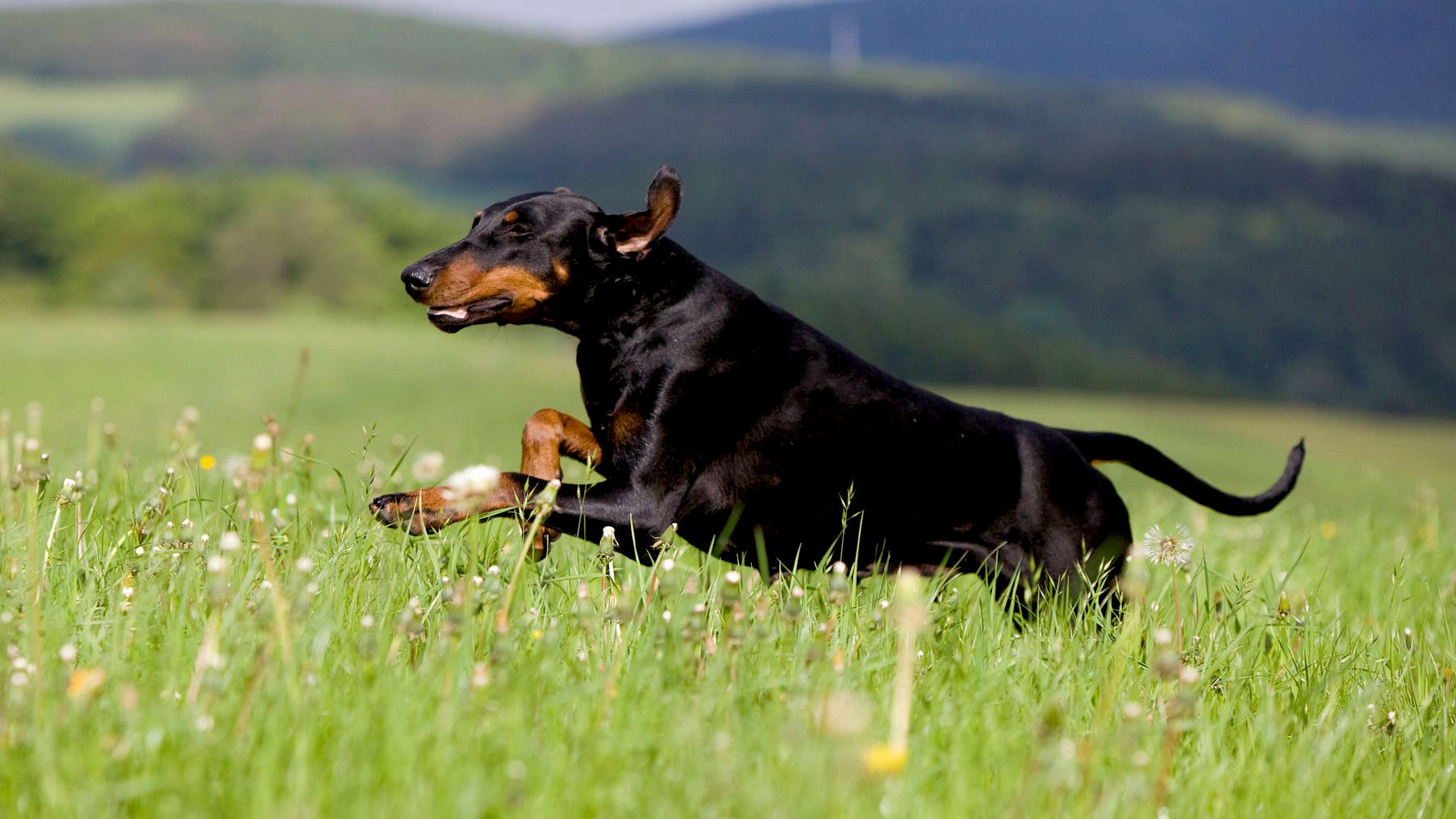
Get to know the Dobermann
All you need to know about the breed
Despite being a comparatively new breed, the Dobermann has quickly established itself as a popular dog across the world. This is especially the case in the US where they have their own distinct variety: the Doberman Pinscher. Although much the same in many ways, the American is slightly slimmer, with more defined lines, a longer arched neck and a narrower head – and even their own name!
What they both very much share in common is that special Dobermann personality. Despite their guard-dog credentials, the Dobermann is actually a very calm, friendly and docile breed once trained. They do, however, have quite a protective streak – and will have no hesitation in fending off an intruder – which is what makes them good defence dogs too.
Developed in Germany in the late 1800’s, the Dobermann is thought to be a mix of Rottweiler, German Pinscher and Black and Tan Terrier. Today, these handsome animals are notable for their sleek and agile bodies, gleaming coat and beautiful brown eyes. Medium to large in size, Dobermanns also tend to be a fairly healthy breed of dog.
Highly intelligent and super-quick learners, Dobermanns are a pleasure to train – and pretty easy to look after with their short, glossy coat. Just one word of warning though: they need a significant amount of activity – both mental and physical – in order to really thrive. But if you’re looking for a dog to spend time with – especially outdoors! – the Dobermann might just be the one for you.
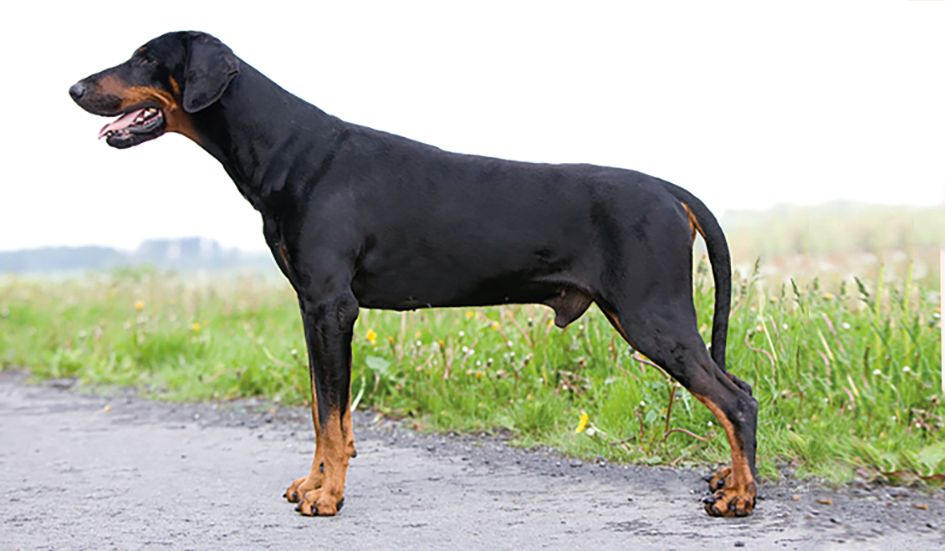
2 facts about Dobermanns
1. Brains and beauty
The Dobermann is regarded as one of the most intelligent breeds of dog in the world. In fact, they rank fifth overall according to canine psychologist Stanley Coren who wrote the seminal book The Intelligence of Dogs (1994).
2. Leader of the pack
One other thing to bear in mind with the Dobermann is that, being naturally smart, they will assert themselves as top dog, given a chance. So they really need an experienced owner who can establish themselves as ‘leader of the pack’, in the immortal words of American girl group The Shangri-Las. For more information on training your Dobermann, see below.
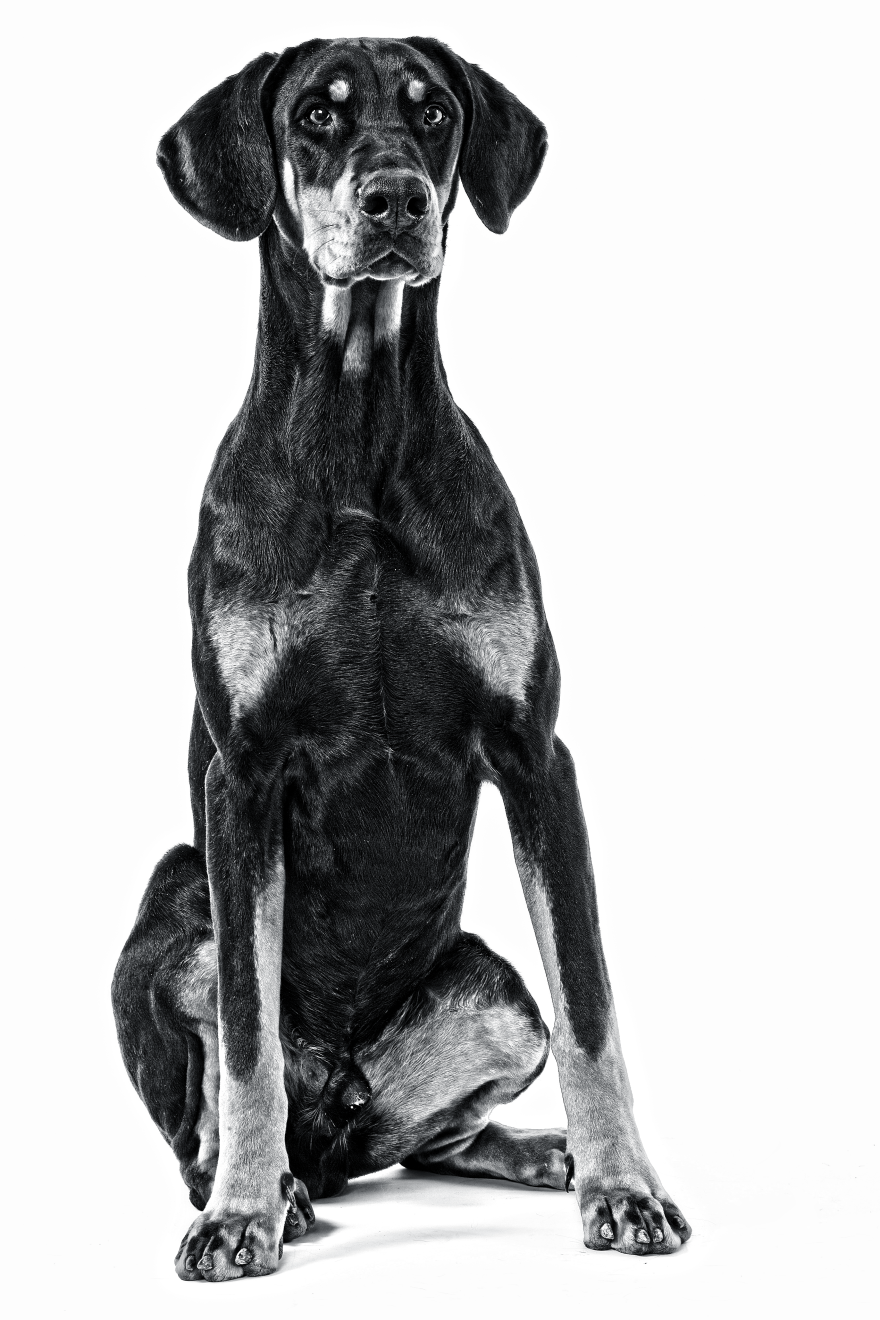
History of the breed
Developed in Germany in the late 1800’s, the Dobermann has a rather unusual history. In the town of Apolda, a tax collector by the name of Louis Dobermann wanted a dog to protect him on his rounds. So he set about breeding the perfect dog for the task – and the Dobermann was the result.
Very quickly, these intelligent and agile animals gained a reputation as an ideal defence dog. As such, Dobermanns were soon utilised by the police and military – particularly in World War Two. In time, they went on to become equally popular as companion animals too.
First recognised by the German Kennel Club in 1900, another important moment came in 1908 when the Dobermann was imported to the US. There, the breed diverged into a new variety – while, back in Europe, the Pinscher part of the name was dropped. Hence how we now have two versions of the breed – both as adorable as the other.
From head to tail
Physical characteristics of Dobermanns
1.Ears
2.Limbs
3.Body
4.Coat
5.Tail
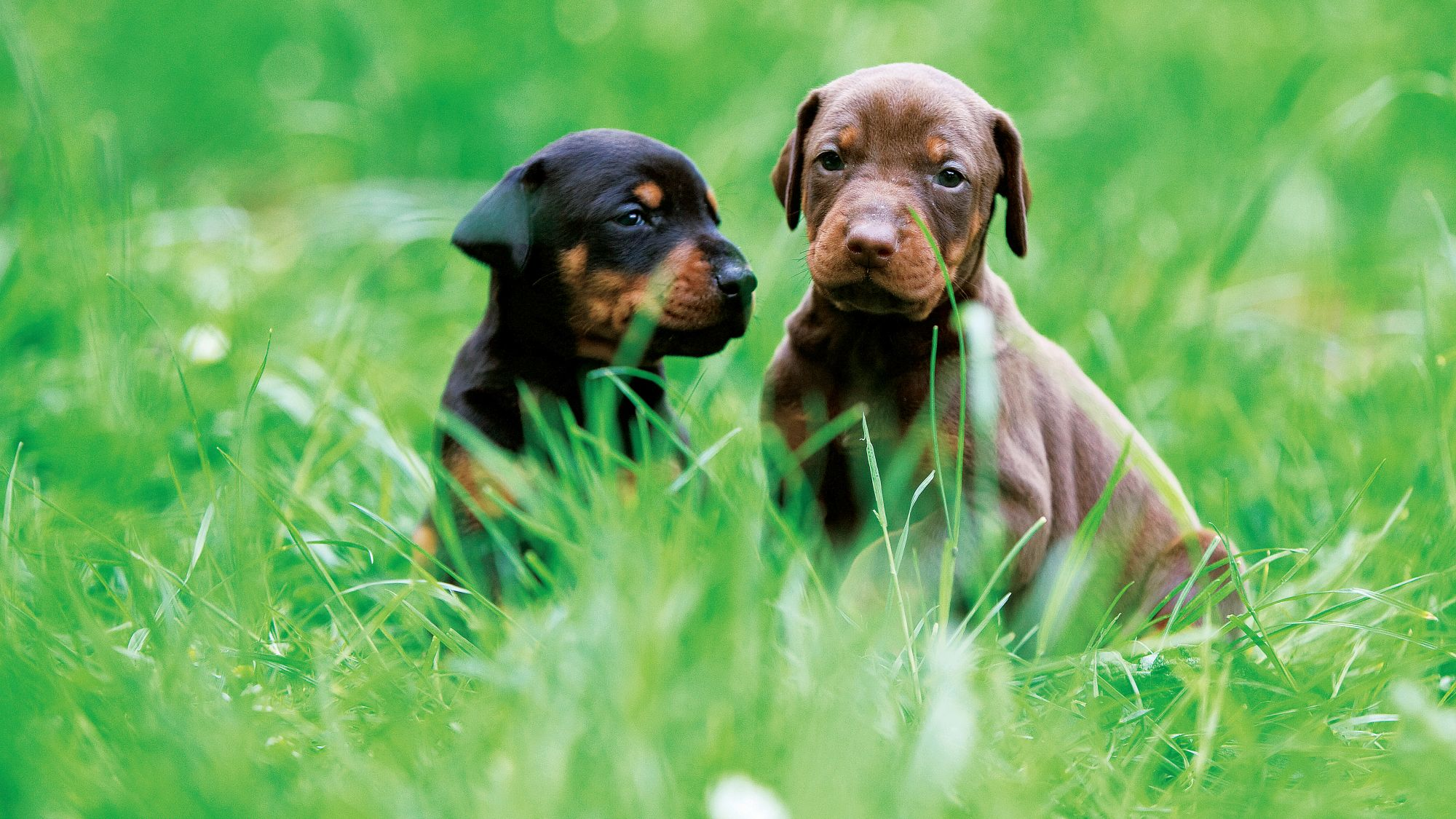
Things to look out for
From specific breed traits to a general health overview, here are some interesting facts about your Dobermann
There are a few health conditions of which to be aware.
Generally a robust breed of dog, Dobermanns have an average lifespan of 10 to 12 years. However, there are one or two health complaints to which they can be prone. In particular, they are “famous” for the dermatological condition ‘colour dilution alopecia’ – a partial or complete loss of hair. They can also be predisposed to a blood-clotting defect called von Willebrand disease and are very sensitive to parvovirus. As always, forewarned is forearmed, so have a chat with your vet who will be able to give the best advice.
Spinning around
One other thing to bear in mind is that Dobermanns can be at risk of a digestive condition called ‘bloat’ (or ‘gastric dilatation and volvulus’). As it can be serious, it’s important to know the signs – which include an extended abdomen, retching and salivation – and take them straight to the vet. Thankfully, as the condition tends to occur only after a large meal, drinking too much water or exercising too soon after eating, it can – for the most part – be prevented.
Healthy diet, healthier dog
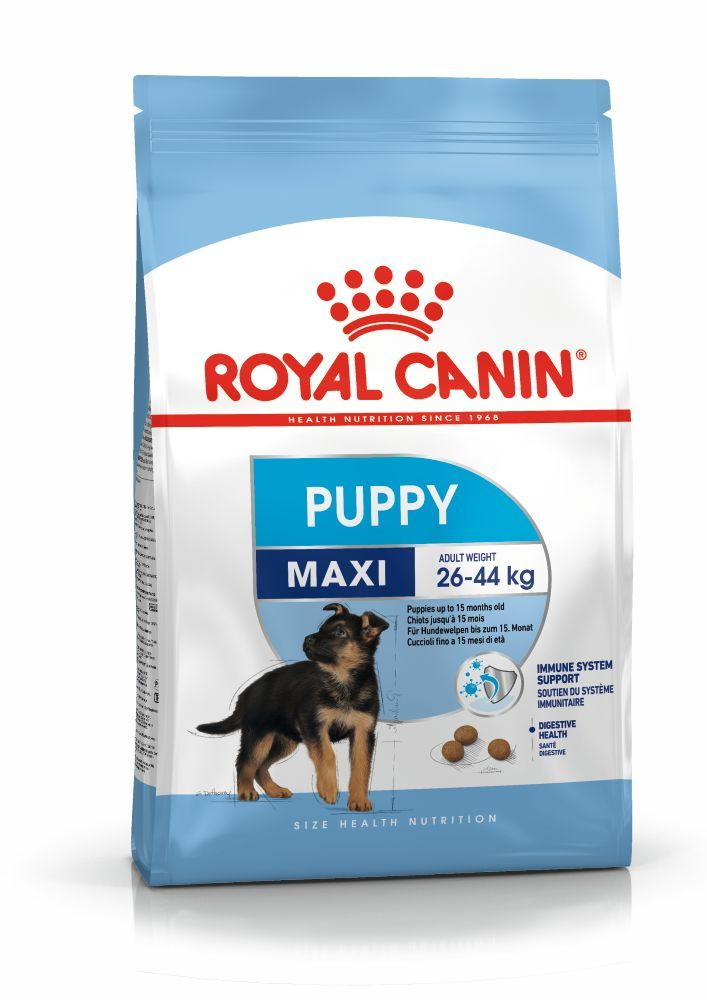
When choosing food for a Dobermann, there are many factors to consider: their age, lifestyle, activity level, physiological condition, and health including potential sickness or sensitivities. Food provides energy to cover a dog’s vital functions, and a complete nutritional formula should contain an adjusted balance of nutrients to avoid any deficiency or excess in their diet, both of which could have adverse effects on the dog.
Clean and fresh water should be available at all times to support good urinary regularity. In hot weather and especially when out exercising, bring water along for your dog’s frequent water breaks.
Energy intake may also have to be adapted to the climatic conditions. A dog that lives outdoors in winter will have increased energy requirements.
The following recommendations are for healthy animals. If your dog has health problems, please consult your veterinarian, who will prescribe an exclusively veterinary diet.
How to Feed Dobermann Puppies (under 15 months old)
A Dobermann puppy’s requirements, in terms of energy, protein, minerals and vitamins, are much greater than those of an adult dog. They need energy and nutrients to maintain their body, but also to grow and build it. Until they are 15 months old, Dobermann puppies’ immune system develops gradually. A complex of antioxidants – including vitamin E – can help support their natural defences during this time of big changes, discoveries, and new encounters. Their digestive functions are different from an adult Dobermann’s, too: their digestive system is not mature yet so it is important to provide highly digestible proteins that will be effectively used. Prebiotics, such as fructo-oligosaccharides, support digestive health by helping balance the intestinal flora, resulting in good stool quality.
It is important to choose a kibble with an appropriate size, shape, and texture. This growth phase also means moderate energy needs. Large-breed puppies, such as Dobermann puppies, whose growth period is long and intense, are especially susceptible to skeletal and joint problems, including limb defects, bone deformities, and joint lesions. The first part of growth is mainly concerned with bone development, although the muscles also start to grow. This means that a puppy that eats too much – takes in too much energy – will put on too much weight and grow too quickly. Limiting the energy concentration of a food for Dobermann puppies and feeding a correct daily amount will help control the speed of growth and minimise these risks.
Concentrations of other nutrients should be higher than normal in a specially formulated growth food. Although the calcium content in the food needs to be increased, maxi-sized breed puppies are more sensitive to excessive calcium intake. As such, it’s important to understand that adding any ingredients to a complete food formulated for the growth phase is at best, unnecessary and at worst, dangerous for the animal, unless prescribed by a veterinarian. Splitting the daily allowance into three meals a day is recommended until they are six months old, after which you should switch to two meals per day.
Throughout their life, it is important to avoid feeding Dobermanns human foods or fatty snacks. Instead, reward them with kibbles taken from their daily meal allowance, and strictly follow the feeding guidelines written on the package in order to prevent excessive weight gain.
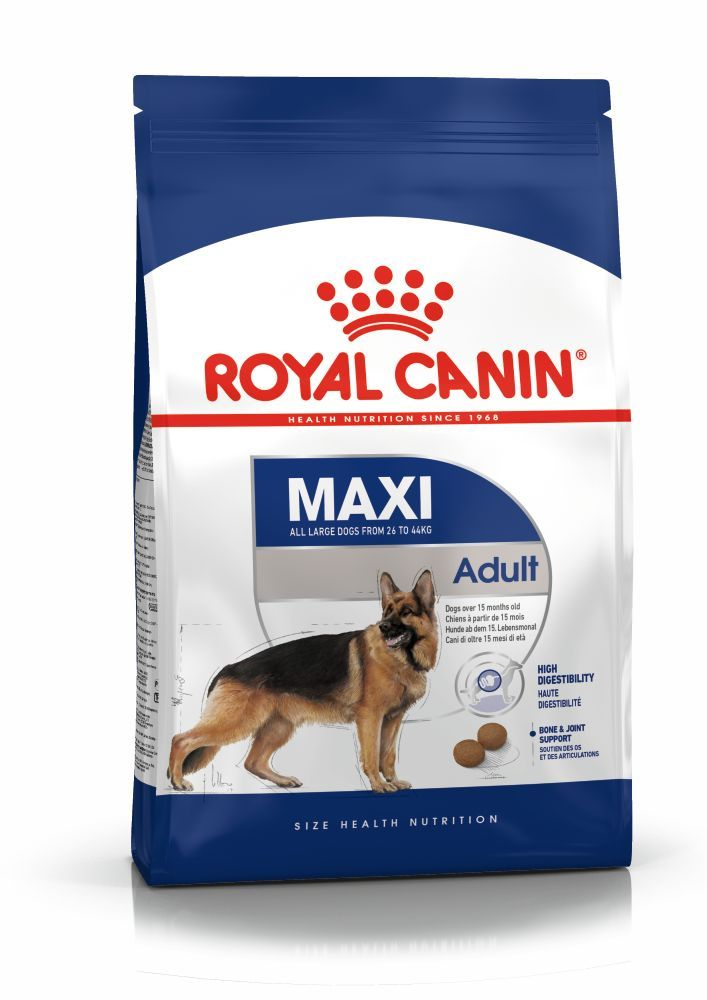
The main nutritional goals for adult Dobermanns are:
Maintaining an ideal body weight by using highly digestible ingredients and keeping the fat content at a sensible level
Helping to support the health of their bones and joints with glucosamine, chondroitin and antioxidants
Promoting optimal digestibility with high-quality protein and a balanced supply of dietary fibre
Helping to preserve the health and beauty of the skin and coat with the enriched addition of essential fatty acids (especially EPA-DHA), essential amino acids and B vitamins.
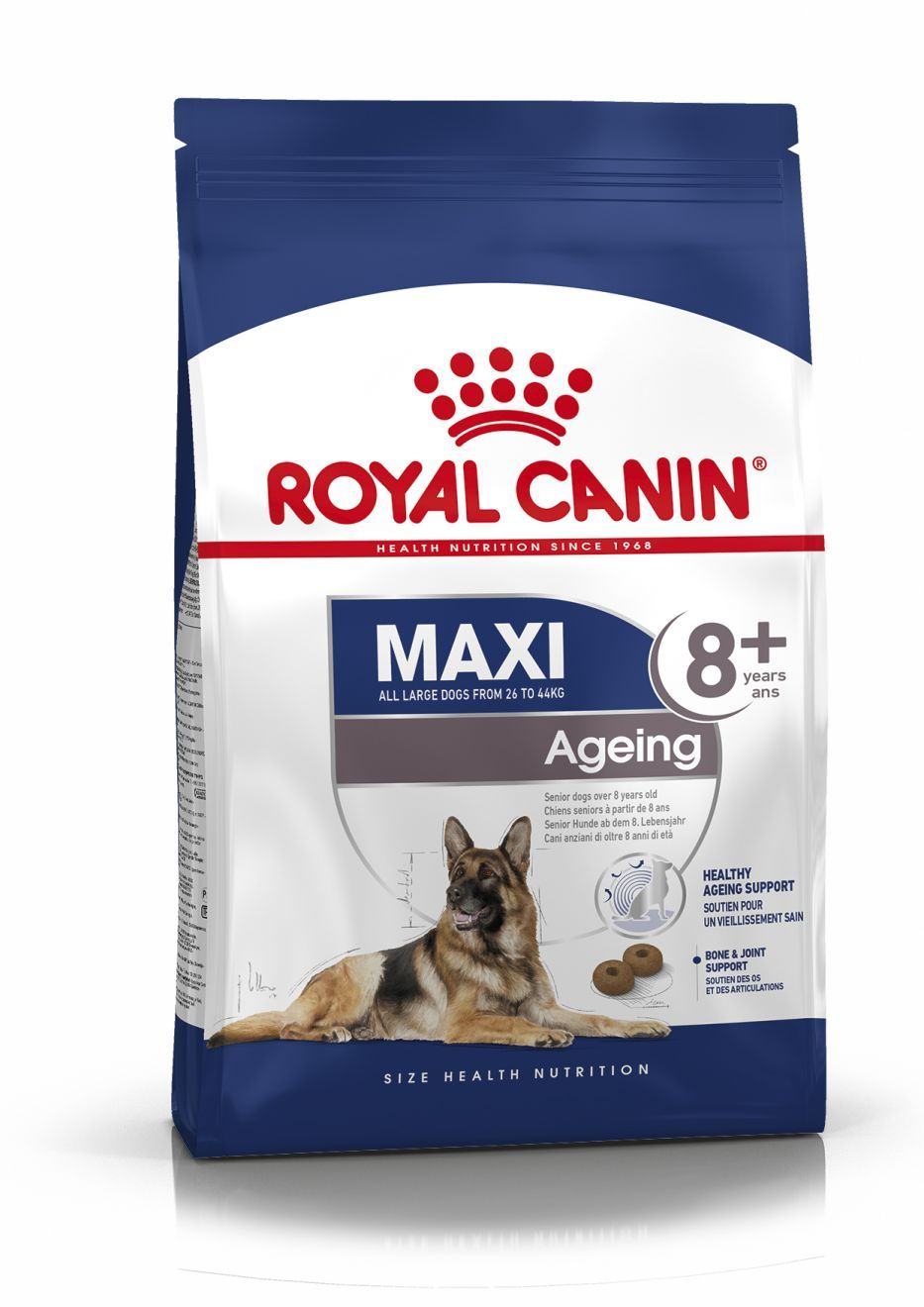
After 5 years old, Dobermanns will start facing the first signs of ageing. A formula enriched with antioxidants will help maintain their vitality, and specific nutrients, such as chondroitin and glucosamine, will help support healthy bones and joints. Ageing is also accompanied by the modification of digestive capacities and particular nutritional requirements, so food for older Dobermanns should have the following characteristics:
Higher vitamin C and E content. These nutrients have antioxidant properties, helping to protect the body’s cells against the harmful effects of the oxidative stress linked to ageing
High-quality protein. Contrary to a widely held misconception, lowering the protein content in food brings little benefit in limiting kidney failure. In addition, older dogs are less efficient at using dietary protein than younger dogs. Reducing the phosphorus content is a good way of slowing down the gradual deterioration of kidney function
A higher proportion of the trace elements iron, zinc and manganese to help to keep the skin and coat in good condition
A higher quantity of polyunsaturated fatty acids to help maintain the quality of the coat. Dogs can normally produce these fatty acids but ageing can affect this physiological process
As they age, dogs increasingly suffer from teeth problems. To ensure that they continue to eat enough, the shape, size and texture of their kibble needs to be tailored to their jaw.
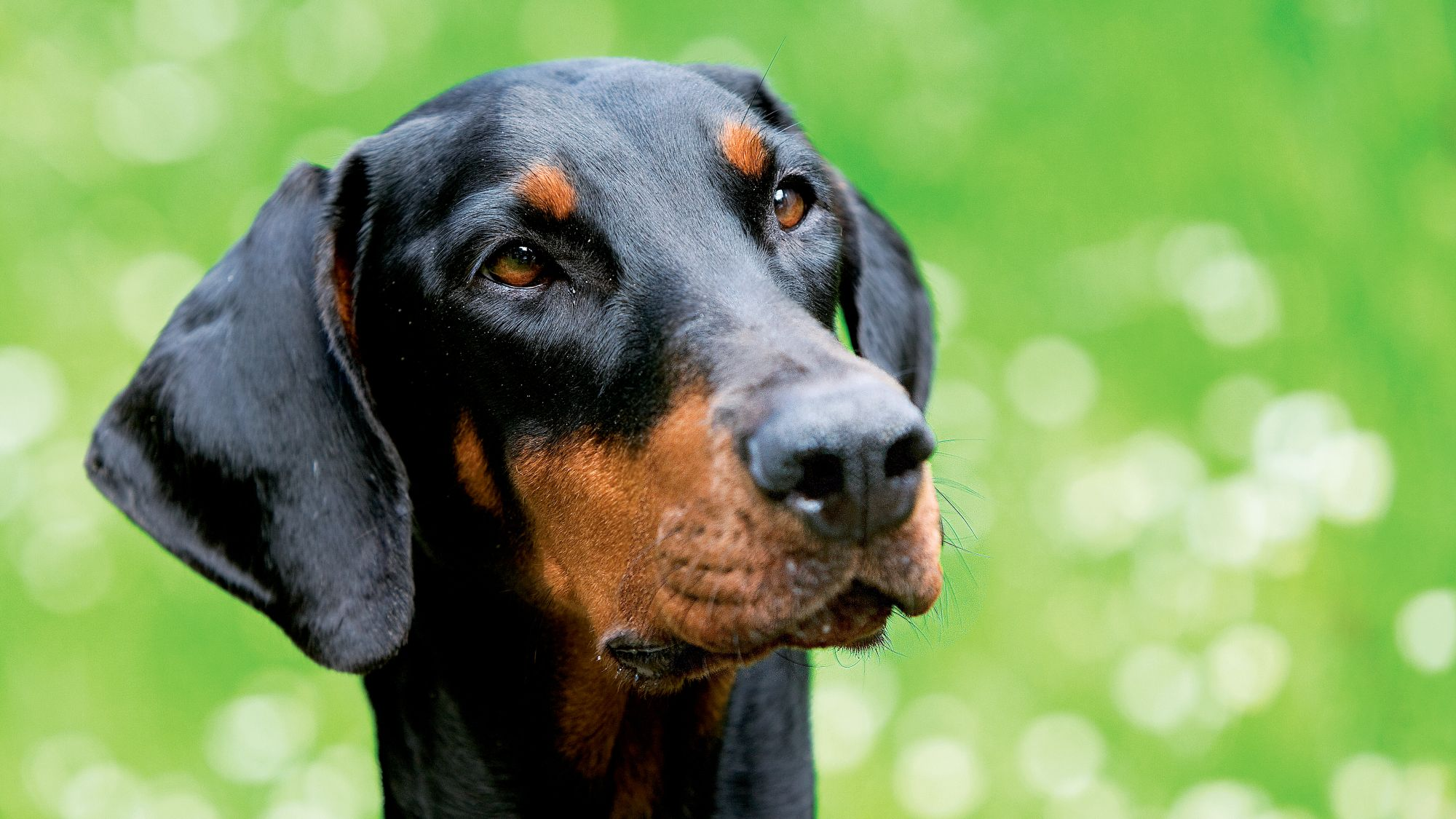
Caring for your Dobermann
Grooming, training and exercise tips
7/7
All about Dobermanns
Despite their fearsome reputation, Dobermanns are very affectionate dogs with a calm and gentle nature. So, as long as they have been socialised and trained properly, Dobermanns are generally fine with children – especially if they have been raised with them since puppyhood. As with all dogs, children should be taught how to interact with Dobermanns respectfully, however, and they shouldn’t be left unsupervised together, just in case.
Because of their background as guard dogs, Dobermanns do have a naturally protective streak and will therefore bark when they perceive a possible threat. However, this is only to alert their owners. A content Dobermann, who has been properly trained and socialised, will not generally bark excessively without good reason.
Suggested Breeds
Read more on this topic
Sources
- Veterinary Centers of America https://vcahospitals.com/;
- Royal Canin Dog Encyclopaedia. Ed 2010 and 2020
- Banfield Pet Hospital https://www.banfield.com/
- Royal Canin BHN Product Book
- American Kennel Club https://www.akc.org/
Like & share this page